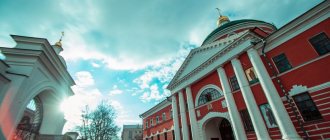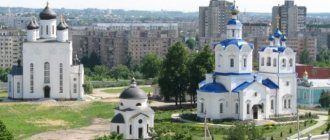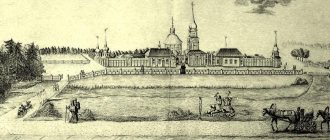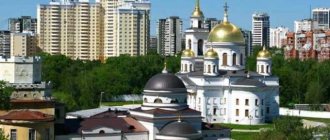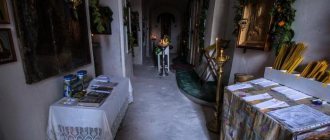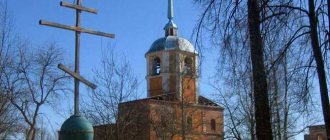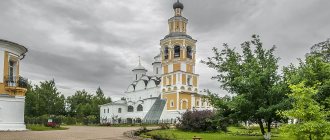| Tambov Kazan Monastery. Photo by Ivan Manchenko from the site sobory.ru |
Kazan Mother of God Monastery in Tambov,
Tambov diocese
- Address: 392000, Russia, Tambov, st. M. Gorky, 3
- Tel.,
- On the map: Yandex.Map, Google map
The Kazan Mother of God Monastery was founded and built in the 17th century on the southern side of the city of Tambov by Elder Joseph.
In 1679, the brethren of the monastery were granted a mill on the rivers Studenets and Tsna in the area of the village of Donskoye. The monastery owned the lands of Trinity Dubrava, Trinity Guard, the village of Three Loschins, the bank of the Karian River and lands near the village of Tatanovo. Due to fires that often occurred in the city of Tambov, the architectural appearance of the monastery changed several times. Its significant reconstruction took place in the middle of the 18th century. With the blessing of Bishop Pachomius of Tambov (1758-1766), a bishop's residence began to be located on the territory of the Kazan monastery. A new wooden bishop's house, consistory, bathhouse, stable yard, and economic services were built next to the fraternal building and the temple.
The stone construction of buildings and temples of the Kazan Monastery dates back to the last decade of the 18th century.
Bishop Theophilus (Raev), who ruled the Tambov diocese in 1788-1811, put in a lot of work on the construction and improvement of the Kazan monastery. On his instructions, two stone churches were erected that have survived to this day - Kazan and St. John the Baptist. The temples were built by the former Sarov novice Nathanael. The history of the construction of the monastery includes the names of Archpriest S. A. Bereznegovsky, an architect by training, and engineer-architect A. S. Chetverikov. The buildings of the monastery were built in the spirit of classicism, which dominated Russian architecture at that time.
The Summer Cathedral Church in honor of the Kazan Icon of the Mother of God was founded in 1791. Consecrated in 1796 by Bishop Theophilus (Raev) of Tambov and Shatsk. The architectural appearance of this temple completely repeats the appearance of the now-unpreserved Assumption Cathedral of the Sarov Hermitage, which at that time belonged to the Tambov diocese. It is significant that in 1793, in the Kazan Monastery, the Reverend Theophilus ordained the Monk Seraphim of Sarov as a hieromonk. Bishop Theophilus (Raev) was buried near the southern wall inside the Kazan Cathedral.
| Tambov Kazan Monastery |
From the end of the 18th century, a necropolis began to take shape on the territory of the monastery.
Here, under the shadow of the monastery churches, many famous representatives of the Tambov region found their rest: clergy, military leaders, philanthropists, scientists. The second monastery church in the name of John the Baptist - the winter one - was founded in 1794, but its construction lasted until 1821. The multi-tiered bell tower of the monastery, built in 1848, has not survived to this day.
Already at the end of the 18th century, the monastery was surrounded by a stone wall with metal gratings. The construction of the wall was completely completed by the beginning of the 19th century. At the beginning of the century, the southwestern part of the monastery wall included a two-story consistory building, as well as a bishop's house, a fraternal building, and an archive building.
The Kazan Monastery was closed on October 19, 1918 “due to the fact of protests against Soviet power during the outbreak of a counter-revolutionary rebellion in Tambov.” During the civil war after the Antonovsky peasant uprising, the Soviet authorities set up a camp in the Kazan monastery, where interrogations and executions of participants in the uprising were carried out. At the same time, under the pretext of the dilapidation of the structure, the majestic bell tower was destroyed. Bricks and crushed stone were used to build a club in the suburbs (now the city of Kotovsk), and the bells, as historical and cultural monuments, were transferred to Glavnauka. For more than 50 years the monastery was in a dilapidated state.
Renaissance
The revival of the Kazan Monastery began on December 22, 1992 under Archbishop Evgeniy (Zhdan).
In 1993, Patriarch of Moscow and All Rus' Alexy II consecrated a chapel in the monastery, erected in memory of those killed during the civil war.
In 2003, Bishop Feodosius of Tambov and Michurin consecrated a chapel in the monastery, erected over the grave of Archbishop Evgeniy (Zhdan) of Nizhny Novgorod and Arzamas (+ 2002), who worked a lot in the field of spiritual revival of the Tambov diocese.
On March 28, 2004, for the first time in the revived monastery, Bishop Theodosius tonsured three inhabitants of the monastery.
In 2005, Bishop Theodosius consecrated the seminary house church in honor of Saints Equal-to-the-Apostles Cyril and Methodius.
The complex of buildings of the Kazan Monastery includes: 3 churches, 2 chapels, the Tambov Theological Seminary, an administrative building, and outbuildings. The monastery has its own small subsidiary farm in the village of Vorontsovka.
The monastery operates a Sunday school for children and adults.
History of the foundation of the monastery
The monastery was founded by Elder Joseph back in 1670 in the city of Tambov, on its southern outskirts. It was large enough and the authorities granted the monks several mills in the area, as well as lands around four neighboring villages and the banks of the Cariana River. Already in 1679, the number of brethren doubled - the monks cultivated the land, fished, sold the harvest and meat they caught at the market in Tambov.
Kazan Monastery in Tambov
Initially, most of the buildings were wooden, but due to numerous fires they were repeatedly rebuilt and constantly modified. Already in the middle of the 18th century, the monastery buildings underwent a complete reconstruction. With Bishop Pachomius coming to power in 1758 (he began to lead the entire Tambov diocese), his residence was located here, which began to gradually change. Under the bishop, a new building was built here for him, a bathhouse and a stable yard were built, several stallions were brought in, and a spiritual consistory was erected. New premises for household needs were built for the monks.
But stone buildings and temples began to be built on the territory of the monastery only in the last decade of the 18th century.
In 1788-1811, Bishop Theophilus, who at that time ruled the Tambov diocese, put a lot of work into the arrangement of the Kazan monastery. It was he who contributed to the construction of two stone churches - Kazan and St. John the Baptist, which still stand today.
The former monk from Saratov Nathanael, as well as the former architect and archpriest Bereznegovsky, participated in the construction of the monastery buildings, and the engineer Chetverikova advised them. Thanks to their work, all buildings and premises of the Kazan monastery were built in strict compliance with the rules of the classical style, which at that time was present everywhere in the architecture of the Russian Empire.
Historical photo of the monastery at the beginning of the twentieth century
Despite its beauty and architectural value, with the arrival of the communists the courtyard was closed in October 1918. The reason was a fabricated case about the participation of monks and their complicity in the counter-revolutionary rebellion that took place in Tambov. Moreover, property and buildings were not only taken away from the church, but the monastery itself became the location of the division headquarters. The holy walls, which previously heard only prayers, now heard the screams and groans of those people who were tortured by the NKVD.
Suspicious people or those who openly opposed the communists were not just interrogated and tortured, but shot. The majestic bell tower, which had always been a decoration of the monastery, was blown up and destroyed under the pretext of old age and the threat of destruction. Its bells were given as a monument to the department of Glavnauka, and bricks and other materials were used to build a club in the city of Kotovsk. The necropolis was also destroyed.
Only in the summer of 1960 the government of the RSFSR recognized the value of the monastery and by decree took it under protection as a monument of republican significance. So it existed until 1992, when by decision of the government it again became part of the Tambov diocese and its path to healing began.
Kazan Mother of God Monastery
The architectural ensemble of the Kazan Monastery includes three cathedrals, two chapels, several service buildings, and a theological seminary. 2014 became a landmark year for the Kazan Monastery. On August 30, the tallest bell tower in its region was consecrated. Its height is about 110 meters, so the cross and the golden dome of the belfry can be seen from all parts of the city on a clear day.
The foundation of the Kazan Monastery dates back to the second half of the 17th century. The first mention of the monastery in chronicles dates back to 1677. Its organizer is considered to be Elder Joseph, who vowed to build a new cathedral outside the walls of the fort. Today this territory is located in the city center, but three centuries ago the southern outskirts of the city fortress passed here.
Now it is difficult to imagine the original appearance of these places; many archival documents have not been preserved. Due to constant fires, the monastery buildings had to be rebuilt more than once. And only by the beginning of the 19th century it acquired its permanent appearance, which was recreated after perestroika. At the same time, the monastery began to serve as the seat of the Tambov bishops.
Temple of the Kazan Icon of the Mother of God, © Igor Butyrskii
Through the efforts of Bishop Theophilus, two stone churches appeared here - Kazan and St. John the Baptist, which can still be seen today. These churches, like the entire ensemble of the monastery, were built in the classical church style, prevailing in Orthodox architecture of that time. The walls of the Kazan temple were covered with images made in one color, the so-called grisaille painting.
In 1918, the Soviet government closed the monastery, expelling the monks. Now the entire complex became the property of the Tambov branch of the Cheka. It was here that after the suppression of the Antonov rebellion the interrogations of the rebels took place. According to some historians, several hundred people were shot in the basements of the monastery. The Bolsheviks deliberately destroy the bell tower and destroy the necropolis where prominent townspeople were buried. In the 50s, various institutions were located on the territory of the Kazan Mother of God Monastery, which caused irreparable damage to the interior decoration of the premises.
The restoration of the churches of the Kazan Monastery and the revival of monasticism began in the nineties of the last century. By decision of the Tambov diocese, a chapel is being built in memory of the Tambov residents who died during the revolution and the fratricidal war that followed. It was illuminated by His Holiness Patriarch of Moscow and All Rus' Alexy II. In 2002, for the first time in many years, three monks were tonsured here.
The complex of the Kazan Monastery in Tambov on the Yandex.Maps panorama
Video about the Kazan Mother of God Monastery
Description
The main cathedral of the monastery is the Church of the Kazan Icon of the Mother of God. Its foundation was laid in 1791, and the fully built temple was consecrated already in 1796. For the church project, the Assumption Cathedral from the Sarov Monastery was taken for consideration. It was here, according to legend, that Seraphim of Sarov was ordained to serve as hieromonk. And in 1811, the building became the last refuge of Bishop Theophilus, who consecrated the temple.
Cathedral of the Kazan Icon of the Mother of God
A complete restoration of the building was carried out in 2007, the great consecration after which was timed to coincide with the 325th anniversary of the Tambov diocese. Today the Kazan Cathedral has 3 tiers and high domes with crosses on them. The cathedral is decorated in blue and white tones and looks extremely elegant. The roof and all metal parts of the temple are covered with bright blue paint, with the exception of the main dome - it is decorated with gold leaf and rises like a bright onion above the temple. The blue domes are covered with golden stars.
Another temple on the territory bears the name of the Church of John the Baptist. Its foundation was laid in 1794, but construction took an incredibly long time and full consecration took place in 1821. During its existence, the temple was repaired several times, but complete restoration was carried out only in 2010. It was then that the five-domed church was recreated, and it was painted red, which today has become the hallmark of the entire monastery.
On a note! The church is a winter church because it has heating and services can be held in the cold season.
In addition to these two majestic churches, on the territory of the Kazan monastery there is also a seminary home church in honor of Cyril and Methodius, as well as two chapels:
- The chapel is a monument to those killed during the Civil War.
- The chapel as a monument to Archbishop Eugene (Zhdana).
The bell tower of the Kazan Monastery, which was rebuilt in 2009 after complete destruction in 1930, also deserves attention.
LiveInternetLiveInternet
On the left is the Cathedral of the Kazan Icon of the Mother of God, on the right is the church in honor of the holy prophet John the Baptist
Story
The Kazan Mother of God Monastery was founded and built in the 17th century on the southern side of the city of Tambov by Elder Joseph. In 1679, the brethren of the monastery were granted a mill on the rivers Studenets and Tsna in the area of the village of Donskoye. The monastery owned the lands of Trinity Dubrava, Trinity Guard, the village of Three Loschins, the bank of the Karian River and lands near the village of Tatanovo. Due to fires that often occurred in the city of Tambov, the architectural appearance of the monastery changed several times. Its significant reconstruction took place in the middle of the 18th century. With the blessing of Bishop Pachomius of Tambov (1758-1766), a bishop's residence began to be located on the territory of the Kazan monastery. A new wooden bishop's house, consistory, bathhouse, stable yard, and economic services were built next to the fraternal building and the temple.
The stone construction of buildings and temples of the Kazan Monastery dates back to the last decade of the 18th century.
Bishop Theophilus (Raev), who ruled the Tambov diocese in 1788-1811, put in a lot of work on the construction and improvement of the Kazan monastery. On his instructions, two stone churches were erected that have survived to this day - Kazan and St. John the Baptist. The temples were built by the former Sarov novice Nathanael. The history of the construction of the monastery includes the names of Archpriest S. A. Bereznegovsky, an architect by training, and engineer-architect A. S. Chetverikov. The buildings of the monastery were built in the spirit of classicism, which dominated Russian architecture at that time.
Temple in honor of the Icon of the Mother of God “Kazan”
The Summer Cathedral Church in honor of the Kazan Icon of the Mother of God was founded in 1791. Consecrated in 1796 by Bishop Theophilus (Raev) of Tambov and Shatsk. The architectural appearance of this temple completely repeats the appearance of the now-unpreserved Assumption Cathedral of the Sarov Hermitage, which at that time belonged to the Tambov diocese. It is significant that in 1793, in the Kazan Monastery, the Reverend Theophilus ordained the Monk Seraphim of Sarov as a hieromonk. Bishop Theophilus (Raev), who reposed in the name of Bose, was buried near the southern wall inside the Kazan Cathedral.
From the end of the 18th century, a necropolis began to take shape on the territory of the monastery. Here, under the shadow of the monastery churches, many famous representatives of the Tambov region found their rest: clergy, military leaders, philanthropists, scientists.
Church in honor of the Holy Prophet John the Baptist.
The second monastery church in the name of John the Baptist - the winter one - was founded in 1794, but its construction lasted until 1821.
The multi-tiered bell tower of the monastery, built in 1848, was destroyed during the Soviet years.
Already at the end of the 18th century, the monastery was surrounded by a stone wall with metal gratings. The construction of the wall was completely completed by the beginning of the 19th century. At the beginning of the 20th century, the southwestern part of the monastery wall included a two-story consistory building, as well as a bishop's house, a fraternal building, and an archive building.
The Kazan Monastery was closed on October 19, 1918 “due to the fact of protests against Soviet power during the outbreak of a counter-revolutionary rebellion in Tambov.” During the civil war after the Antonovsky peasant uprising, the Soviet authorities set up a camp in the Kazan monastery, where interrogations and executions of participants in the uprising were carried out. At the same time, under the pretext of the dilapidation of the structure, the majestic bell tower was destroyed. Bricks and crushed stone were used to build a club in the suburbs (now the city of Kotovsk), and the bells, as historical and cultural monuments, were transferred to Glavnauka. For more than 50 years the monastery was in a dilapidated state.
The revival of the Kazan Monastery began on December 22, 1992 under Archbishop Evgeniy (Zhdan).
Chapel in memory of the dead
In 1993, in the Kazan Monastery of the city of Tambov, His Holiness Patriarch of Moscow and All Rus' Alexy II consecrated a chapel erected in memory of those killed during the civil war.
In 2003, Bishop Feodosius of Tambov and Michurin consecrated a chapel in the monastery, erected over the grave of Archbishop Evgeniy (Zhdan) of Nizhny Novgorod and Arzamas (+ October 11, 2002), who worked a lot in the field of spiritual revival of the Tambov diocese.
Since 2002, the holy archimandrite of the monastery has been His Eminence Theodosius, Bishop of Tambov and Michurinsky. On March 28, 2004, for the first time in the last 85 years, Bishop Theodosius tonsured three monastery residents at the monastery.
Bell tower of the Kazan Monastery
The bell tower of the Kazan Monastery is the highest in the Central Federal District and the second largest in Russia, second only to the spire of the Peter and Paul Cathedral in St. Petersburg. Its height is 107 meters, although the documents indicate 96.6; According to the head of the architectural and construction department of the Tambov diocese, Archpriest Georgy Neretin, this is explained as follows: “Design documentation for objects with a height of more than 100 meters is being considered in Moscow. It was more convenient for us to resolve issues in the region. So we recorded a lower altitude.”
In 2014, during his primal visit to Tambov, His Holiness Patriarch Kirill consecrated the newly built bell tower.
The Kazan Monastery has a monastery in the village of Vorontsovka, Tokarevsky district, Tambov region. On the territory of the monastery there is a temple in honor of St. Nicholas the Wonderworker, as well as a small farmstead.
https://monasterium.ru/monastyri/monastery/kazanskiy-muzhskoy-monastyr-goroda-tambova/
https://ru.wikipedia.org/wiki/
Activities of the parish
Today the Kazan monastery is active and not only monks, but also students of the Tambov Theological Seminary live on its territory. The monastery also runs a Sunday school for children, as well as for adults who want to become part of the church.
Divine service in the Church of St. John the Baptist of the Kazan Monastery
Pilgrims come to Tambov to visit the monastery on a tour or to visit holy places. They can take part in services that take place according to the schedule:
- From Monday to Saturday at 7 a.m. Divine Liturgy, prayer service and funeral lithium. At 16.15 there is a funeral service and at 16.50 evening service and matins.
- During Saturday holidays, an all-night vigil is held at 17.00.
- During Sunday holidays, the Divine Liturgy takes place at 7.30 am.
Special festive services are held here during the first throne holidays - days of remembrance:
- Icons of the Mother of God “Kazan” - July 21 and November 4;
- Nicholas the Wonderworker - May 22 and December 19;
- John the Baptist - September 11;
- Cyril and Methodius - May 24.
The founder Joseph, Saint Nicholas, as well as the brothers Cyril and Methodius along with John the Baptist are considered the holy ascetics of the monastery.
Kazan Mother of God Monastery
First mentioned in 1677.
Due to fires that often occurred in the city of Tambov, the architectural appearance of the monastery changed several times; it was finally formed only at the end of the 18th – beginning of the 19th century, when the monastery began to serve as the residence of the Tambov bishops. Now the ensemble of the Kazan Mother of God Monastery is a monument of church architecture of the late 18th century, the complex of buildings of which includes: 3 churches, a bell tower, 2 chapels, the Tambov Theological Seminary, an administrative building, and outbuildings.
The main temple of the monastery is considered to be the summer Kazan Cathedral, built in 1796 by masters of the Sarov Monastery. The architectural appearance of the Kazan Church repeats the appearance of the now no longer preserved Assumption Cathedral of the Sarov Hermitage. The walls of the cathedral are decorated with grisaille painting - a one-color graphic image in halftones. The cathedral is famous for the fact that in 1793 St. Seraphim of Sarov was ordained there as a hieromonk. The ordination was performed by Bishop Theophilus (Raev), whose ashes rest in this cathedral. The second monastery church (winter) in the name of the Nativity of John was founded in 1794, but construction lasted until 1821.
The construction of the six-tiered bell tower of the monastery in 1848 completed the formation of its architectural appearance.
The Kazan Monastery was closed on October 19, 1918. During the civil war after the Antonovsky peasant uprising, the Soviet authorities set up a camp in the Kazan monastery, where interrogations and executions of participants in the uprising were carried out. At the same time, the majestic bell tower was destroyed. After 1945, the monastery buildings housed the state archive and a training and production plant. For more than 50 years the monastery was in a dilapidated state.
The revival of the Kazan Monastery began at the end of 1992. Both churches underwent reconstruction; the bell tower was restored on a site close to the original one. The golden dome of the bell tower and the huge luminous cross on its top are visible from almost anywhere in the city. The bell tower consists of five tiers with a gate temple-chapel at the base; between the fourth and fifth tier there is a large chime-type clock. The new bell tower, equipped with a rich set of bells, is considered the highest in the Central Federal District and the second largest in Russia, second only to the spire of the Peter and Paul Cathedral in St. Petersburg. Its height is 107 meters.
